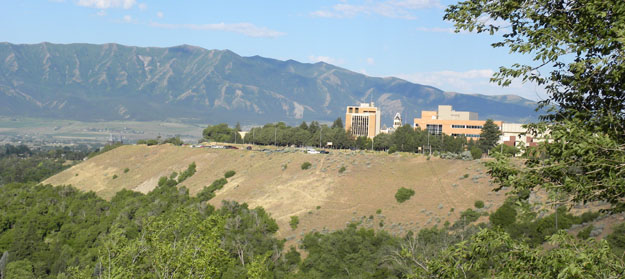LOGAN, UTAH–The Wooster geology team currently in central Utah pointed out in the distance Pahvant Butte which has a set of relict shorelines from the famous — and immense — Lake Bonneville. In the spirit of sharing common field experiences between Wooster geologists this summer, we have Bonneville shorelines up here in northern Utah as well. This pluvial lake was extraordinarily large, filling a good portion of the Great Basin between 32,000 and 14,500 years ago. Its shores were energetic with strong waves pounding away at the confining mountain slopes and forming wave-cut platforms which extended inland hundreds of meters in some places. The area around Logan, Utah, has especially well developed Bonneville shoreline platforms.

Looking west at the Utah State University campus in Logan sitting on a Lake Bonneville wave-cut platform. In the background are the Wellsville Mountains, with the Cache Valley in between.

Wave-cut platforms (or terraces) on the flank of the Bear River Range in Logan, Utah. The oldest levels are the highest because they have eroded away previous shorelines. The lower platforms represent decreasing lake levels over time.
The Great Salt Lake of Utah is a remnant of the once vast Lake Bonneville. Tomorrow I hope to see where the lake catastrophically drained about 14,500 years ago (the Bonneville Flood).



Pingback: Wooster Geologists » Blog Archive » The Bonneville Flood and where it began